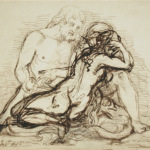Blogpieces for Beloved, Jazz and Paradise
Entering into the emotional dramas and ancestral landscapes of Toni Morrison's novels can be daunting but also exhilarating, and sometimes sobering. Vivid passages can lead us to discover new ways of being in the world as sheer, concrete descriptions rock us
Although she has claim, she is not claimed.In the place where long grass opens, the girl who waited to be loved and cry shame erupts into her separate parts, to make it easy for the chewing laughter to swallow her all away.
This is Morrison's descriptive metaphor for how the character called Beloved disappeared from the house on 124 Bluestone Road.
What do you feel about this young woman after reading this?

You see, I want to know what you think. I want us to be able to share our responses to not only specific image-scenes, as in the above example, but to the emotional arcs of all of the characters; to the landscapes and ancestral territories, to the esthetic experiences of readers encountering dramatic arrangements of the parts of the story, the juxtapositions and oppositions.

Joy Deb /Pexels
That's why I've created what I call "blog-pieces": "blog" to retain the character of a short writing--with images, video links, musical links, and the like--and "pieces" to evoke what are essentially informal, reflective non-fiction pages that speak directly to the reader.
Blogpieces are Organized into 3 Sections:
FOUNDATIONS: Root Blogs, Reader's Participation & Emotional Story Structures
THE HEART OF THE MATTER: Time & Memory, Claiming Geographic Space, Music & Intermediality
LARGER CONTEXTS: More on Aesthetics, Morrison's Intertextuality, & Race and Response-ability
9 BLOGPIECE "CLUSTERS": One way of going through these is to from the upper left to the lower right. But you can browse as you wish! Happy Reading and Responding!
ALTERNATIVE: A Chronological unfolding of the blogs--to see each blog in sequence
“Stories and works are largely incomprehensible without reference to the emotions systems.” —Patrick Hogan, Affective Narratology: the Emotional Structure of Stories Toni Morrison has stated that one of her primary goals as a writer is to work with language in such ways that it can “enunciate race while depriving it of its lethal…
Read MoreThis is the expression used to describe Consolata’s visceral emotional response to seeing Deacon Morgan for the first time as he rode by her on his horse. What are we to make of this sound signifying Connie’s initial response to the man with whom she would be having a love affair?
Read MoreWith subversive love as a primary concern in Toni Morrison’s Beloved trilogy, Morrison has set a stage, so to speak, upon which readers will encounter the intense, often fraught and frequently poignant, emotional episodes of characters in their narrative worlds. And how readers respond to these will depend on so many elements: personal experiences and…
Read MoreNovels and stories worldwide share prototypical story structures or plots; for instance, Patrick Hogan identifies 3 “universal narrative prototypes”: Sacrifice, Heroism, and Romantic Love, each of which has many variants. Yet in order to comprehend prototypes in African American literature in general, and in Toni Morrison’s work in particular, we have to turn to the…
Read MoreThis blog invites you on a journey to find “blues people” in Beloved, Jazz, and Paradise and follow the arcs of their blues-durative emotional story structures. (see The Roots of Toni Morrison’s Durative Blues and Emotional Story Structures for more on those concepts). We will explore the following questions with each of the novels: 1. By examining some possible blues-based…
Read MoreIf we are engaged in what happens to the fictional human beings in Beloved, Jazz, and Paradise, we will have emotional reactions to them: we will simulate their experiences. But will we have empathy for them, feel affinity with them? If we are non-African Americans, will we expand our understanding of and compassion for…
Read More“We want poems that kill” –Leroy Jones (Amiri Baraka), “Black Art,” 1965 Seriously. Amiri Baraka created the Black Arts Repertory School–BARTS–Theatre in Harlem in 1965 following the assassination of Malcolm X, and for him, art was to be a cultural weapon. The literary poems, plays, and essays by African American writers Stephen Henderson, Larry Neal,…
Read MoreIf you work very carefully, you can clean up ordinary words and repolish them, make them seem alive again. –Toni Morrison interviewed by Nellie McKay Why a separate entry on description per se? Because there is every good reason for readers of the trilogy to respond to her descriptive artistry as such, without suborning it to…
Read MoreSets of related images, sprinkled across Toni Morrison’s trilogy, create a rhythmic experience for readers. Certain types of images are repeated within a novel, and across all three of the trilogy novels. What are some of these, and how might readers experience their reoccurrence in different contexts? Why is this repetition such a significant feature…
Read More“Throughout the history of black music in the United States, it has been through the repetition and revision of texts, through the interplay of black language and black music in a long chain of Signifyin(g) tropes, that African-American peasants became and continue to be poets in a land that initially denied them the right…
Read More- « Previous
- 1
- 2
- 3
- 4
- Next »



















